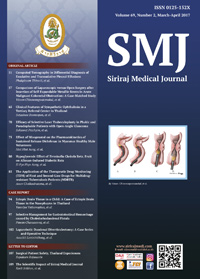Computed Tomography in Differential Diagnosis of Exudative and Transudative Pleural Effusions
Keywords:
Pleural effusion, attenuation, CT, transudates, exudatesAbstract
Objective: To differentiate between exudative and transudative pleural effusions by using CT attenuation values and CT appearances.
Methods: The retrospective study reviewed 132 patients who were diagnosed of pleural effusions in 2007-2014. All patients were evaluated by chest CT images before or after pleural tapping within 2 days. Pleural effusions were classified as exudates or transudates based on Light’s criteria.1 Pre-contrast and post-contrast CT images were reviewed by measuring the mean attenuation values of pleural effusions and the associated CT findings.
Results: Pleural effusions were 112 exudates and 20 transudates. Exudate group had significant higher mean attenuation values, compared with a transudate, in both pre-contrast (12.8±5.0 HU vs. 9.4±5.2 HU; p<0.001) and post-contrast images (13.8±5.1 HU vs. 10.2±5.7 HU; p=0.006). For differentiation between types of pleural effusions, the CT attenuation cutoff value of 8.5 HU showed highest sensitivity of 84.5% and the cutoff value of 16 HU showed highest specificity of 95%, respectively. The CT findings of pleural nodule, pleural thickening and loculation were more common in exudates, compared with transudates with the statistical significance and specificity of those findings as high as 100%, 90%, and 75%, respectively.
Conclusion: The mean attenuation values of ≥16 HU favor exudates. However, the use of CT attenuation values for differentiating types of pleural effusions alone, showed poor diagnostic performance. Correlation with clinical context and pleural fluid analysis are still essential. We suggest the three helpful CT findings for diagnosis of exudates which are pleural thickening, pleural nodules and loculation.
Downloads
Published
How to Cite
Issue
Section
License
Authors who publish with this journal agree to the following conditions:
Copyright Transfer
In submitting a manuscript, the authors acknowledge that the work will become the copyrighted property of Siriraj Medical Journal upon publication.
License
Articles are licensed under a Creative Commons Attribution-NonCommercial-NoDerivatives 4.0 International License (CC BY-NC-ND 4.0). This license allows for the sharing of the work for non-commercial purposes with proper attribution to the authors and the journal. However, it does not permit modifications or the creation of derivative works.
Sharing and Access
Authors are encouraged to share their article on their personal or institutional websites and through other non-commercial platforms. Doing so can increase readership and citations.











